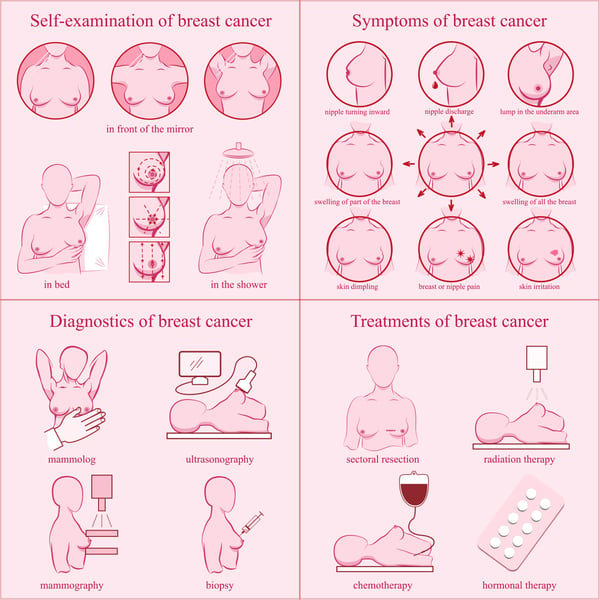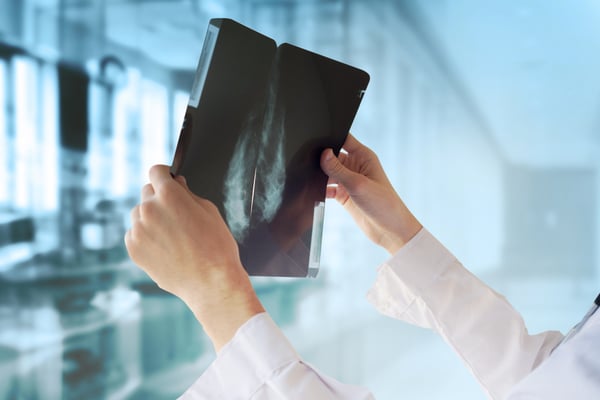Many of us have heard about breast cancer, but not all of us are aware of the importance of early breast cancer screening to avert the spread of the disease throughout the body. Much like in other types of cancer, cells in the breast form a tumour that feels like a lump. This lump can develop in both men and women but is much more common in women. The tumour is malignant and deadly if the cells invade surrounding tissues or even worse, spread to other areas of the body.
In 2018, breast cancer was found in over 2 million people, accounting for 11.6% of all cancer incidences. This ranked it second in the world, only being topped by lung cancer by a mere 5,000 cases. Nevertheless, with 627,000 deaths it ranked fifth worldwide, illustrating the fact that modern medicine and clinical trials are better equipped to treat breast cancer than other types of cancer.
Breast cancer is the most commonly occurring cancer among women. The risk factors of this cancer include genetics, increasing age, the density of breast tissue, estrogen exposure and hormone treatments. Yet, it is also associated with lifestyle elements such as dietary intake and alcohol consumption. Diets low in fiber, high consumption of caloric foods and a transition to a more Western diet may increase the chance of breast cancer. Sustaining a healthy, balanced lifestyle can help to reduce the risk of developing breast cancer.
Prevalence of Breast Cancer in Thailand
According to recent research published in 2017 titled ‘National and Subnational Population-Based Incidence of Cancer in Thailand: Assessing Cancers with the Highest Burdens’, there are five types of cancer that contribute to more than half of the cancer burden in Thailand, one of which being breast cancer. The research found that the average annual percentage change of breast cancer was an increase of 3.1% nationwide.
In 2012, breast cancer was the most common type of cancer among women and this is expected to persist to 2025. Looking at the different regions in Thailand, the incidence of this cancer increased remarkably across the board, from 3% to 7% annual increases depending on the region. This is possibly associated with the fact that 44.9% of women in Thailand categorised as overweight or obese women, which is known to be one of the major risk factor of postmenopausal breast cancer. As reported by the Global Cancer Observatory in 2018, breast cancer represented 22.8% of cancer cases among women in Thailand at 19,510 cases. No men were recorded being diagnosed with breast cancer that year.
Signs and Symptoms of Breast Cancer
There are many symptoms that might indicate a case of breast cancer. The main and most common symptom is a lump or mass in the breast or armpit areas, which feels different from surrounding tissue. However, some breast tissues are naturally lumpy and you should be aware of what feels ‘normal’ to you.
Other symptoms include the following:
- Discomfort in the armpits or breast for a period of a month or more (Some breast pain can be normal, especially around the time of your period)
- Pitting or redness on the skin of the breast
- Rash around or on the nipples
- Sunken or inverted nipples
- Any sudden and unusual change in size, the shape of the breast or appearance of the nipples
- Scaling, peeling, or flaking on the skin of the breast or nipples
- Nipples discharging fluids other than breast milk, without squeezing it
If any of these symptoms sound familiar to you, please do not hesitate to seek medical attention. If in doubt, it is better to get checked out by a medical professional.
Breast cancer can be both invasive and non-invasive. Non-invasive tumour cells stay inside the lobules or ducts and have not yet broken out, but eventually can still become invasive. They are considered invasive when the cancer cells break out from their place of origin and invade close-by tissues and increase the risk of spreading to other parts of the body. Breast cancer is considered to occur in two forms, ductal carcinoma and lobular carcinoma, based on the place of origin.
Ductal carcinoma means that the cancer started in the milk ducts, this is the most common type of breast cancer.
Lobular carcinoma on the other hand begins in the lobules, which are the glands that produce milk.

How Often Should I Examine Myself?
It is advised to do a breast self-exam routine on a monthly basis.
This regular self-check plays an important role as an early detection step and should be combined with other screening approaches. The more regularly you examine, the better you get to know what’s ‘normal’ for you and your breasts. It will become easier for you to spot any unusual changes, signs and symptoms if you’re checking regularly.
Have a good feel of the area around your breasts; the upper area, the outer area and the area around your armpits and collar bones as these areas often show the most prominent lumps or bumps. This applies to both men and women.
You may also start your own journal to track an account of your findings. Take note of the parts where you find lumps or unusual development, this may help you remember your body’s monthly changes. Women should be aware that throughout your monthly cycle your breasts will naturally change around the time of your period.
How Often Should I Go for A Mammogram?
There are several methods to detect breast cancer such as imaging tests like mammograms, ultrasound scans, and biopsies.
The mammogram is a type of x-ray test ordinarily used for initial screening and helps to detect any abnormalities around the breast area. The digital x-ray machine takes pictures from at least two different angles and creates a set of images called a mammogram. The risk of breast cancer increases with age and so it is very important for all menopausal women to do a mammogram at least once a year.
The American Cancer Society suggests that women between the ages of 40 and 44 can get yearly screening if they prefer, but women between the ages of 45 and 54 should do one each year. Research has already shown that doing mammograms regularly improves the rate of survival in breast cancer.
In addition to a mammogram, an ultrasound scan can discern between a solid mass or a fluid-filled cyst in the breast. An Ultrasound needs to be combined with a mammogram for more effective screening.
For further confirmation, a biopsy will be performed through laboratory analysis of a surgically removed sample of tissue. This method is used to determine whether the cells are cancerous, the type of cancer, and whether the cancer is hormone-sensitive or not.

Where Can I Find the Leading Women’s Health Hospitals in Thailand?
Various world-class health facilities in Thailand provide mammograms or any other screening approaches for breast cancer.
Samitivej Hospital is also among the first choice of health facilities for women healthcare with branches all over Thailand; Sukhumvit, Srinakarin, Chinatown, Thonburi, Chonburi, Sriracha and several outreach clinics. These hospitals have proven to be among the most preferred in Thailand as two of the branches, Samitivej Srinakarin and Samitivej Sukhumvit, were awarded a spot in the Top 5 World’s Best Hospitals for Medical Tourism in 2018. Another noteworthy hospital is the BNH Hospital, the first international private hospital in Thailand for 6 royal reigns. With medical expertise of over 121 years, this hospital offers comprehensive women’s healthcare and has attained the accreditation of the Joint Commission International. Moreover, BNH Hospital gained an award for being a hospital of choice for Australians in Thailand as well as winning the Canadian Best Services Award - Export Service in 2007.
Other than that, Bumrungrad International Hospital located in Bangkok, for example, is Asia’s first hospital accredited by the Joint Commission International in 2002.
No matter how healthy you are having comprehensive health insurance is vital in ensuring you get the best care to help prevent and manage breast cancer.
.png)


